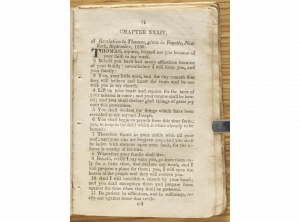Historical Context and Background of D&C 31
Brief Synopsis by Steven C. Harper
Thomas Marsh ran away from home at age fourteen. He made his way to New York City and then to Boston, where he worked in a foundry, making type for printing presses. Later, Thomas and his wife Elizabeth joined Methodism, which satisfied her but not him. He “expected a new church would arise, which would have the truth in its purity.”
In 1829 the Holy Ghost led Thomas to take a trip west in search of this new church. In Lyonstown, New York, a woman asked Thomas if he had heard of the Book of Mormon. He had not, but he wanted to know more. She referred him to Martin Harris in Palmyra. Thomas found Martin at Grandin’s, where the first sixteen pages of the Book of Mormon had just been struck off. Thomas took one of the first copies and went with Martin to the Smith home, where Oliver told him all about the Book of Mormon.
Thomas headed home to tell Elizabeth, who was as excited by the news as he was. When they learned that the Church had been organized in April 1830, they moved to New York, where the Lord revealed section 30 through Joseph to Thomas at the Church’s second quarterly conference in September.1
This revelation marked a turning point for Thomas Marsh. His years of seeking the gospel were over; his years of declaring it were about to begin. The revelation’s rich metaphors spoke to Thomas. As a physician he served Saints who were sick, but at least as important was his work prescribing the gospel of repentance.2 He was also to be a farmer of souls, to cut and bundle wheat all day long before it grew too late.
Thomas obeyed this revelation falteringly. He helped build the local branch of the Church, and when it was time to gather, he led them from Fayette, New York, to Ohio. The New York Saints converged at Buffalo, where the harbor was frozen. Places to stay while waiting for a sufficient thaw were at a premium. Prices were high, supplies low. Conditions were calculated to test Thomas’s willingness to declare the gospel and to try his patience and meekness. “You will be mobbed before morning,” Thomas Marsh told Joseph’s mother Lucy when she refused to keep her faith secret. “Mob it is, then,” she shot back, “for we shall sing and attend to prayers before sunset, mob or no mob.”3
Thomas presided unevenly over the Quorum of Twelve Apostles from 1835 until 1838. He led them on a mission to the eastern United States and tried to heal wounds created by widespread dissent and apostasy in 1837. But then Thomas himself came out against Joseph Smith in 1838 and spent almost two decades outside the Church before he wrote to Church leaders in 1857, seeking “reconciliation with the 12 and the Church whom I have injured.” Thomas humbly acknowledged as he wrote, “The Lord could get along very well without me and He has lost nothing by my falling out of the ranks; But O what have I lost?”4 Reconciled to the Redeemer who gave him Section 31, Thomas died in the faith in 1866.
1. Millennial Star, 26:24 (June 11, 1864): 375–376.
2. “History of Thos. Baldwin Marsh,” Deseret News, 24 March 1858, 18.
3. Scot Facer Proctor and Maurine Jensen Proctor, editors, The Revised and Enhanced History of Joseph Smith by His Mother (Salt Lake City: Bookcraft, 1996), 259–77.
4. Thomas B. Marsh to Heber C. Kimball, May 5, 1857, Church History Library, The Church of Jesus Christ of Latter-day Saints, Salt Lake City, Utah.
Additional Context, by Casey Paul Griffiths
From Doctrine and Covenants Minute
As news of the Book of Mormon spread, a growing group of new and gifted converts began to gather to the young Church. Thomas B. Marsh was from Charlestown, Massachusetts, and was affiliated with the Methodist Church when he first heard about the new scripture in 1829. According to his own recollection, “I thought the spirit required me to make a journey West.” His journey eventually lead him to the Palmyra area where he first heard of the printing of the Book of Mormon. While in Palmyra, he met with Martin Harris and saw proof sheets of the Book of Mormon. He also met with Oliver Cowdery, who “gave [him] all the information concerning the Book [he] wanted.” He traveled back to his home with a proof sheet that contained the first sixteen pages of the Book of Mormon. After learning of the Church’s organization, Marsh moved with his family to Palmyra in the fall of 1830. Shortly before the second conference of the Church, he was baptized by David Whitmer and ordained an elder by Oliver Cowdery (“TB Marsh,” Historian’s Office, Histories of the Twelve, ca. 1858–1880, CHL).
According to Joseph Smith’s history, the Prophet received this revelation on behalf of Thomas B. Marsh during the second conference of the Church held on September 26, 1830.
Historical Introduction, Revelation, September 1830-F [D&C 31]

